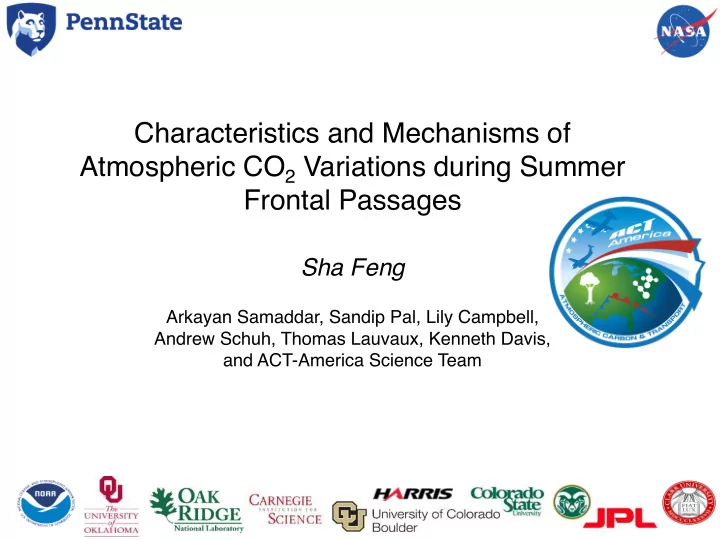

Characteristics and Mechanisms of Atmospheric CO 2 Variations during Summer Frontal Passages Sha Feng Arkayan Samaddar, Sandip Pal, Lily Campbell, Andrew Schuh, Thomas Lauvaux, Kenneth Davis, and ACT-America Science Team
Outline • Characteristics and mechanisms of atmospheric CO 2 variations across fronts Ø Case study: August 4 th front Ø All summer frontal cases • Summary • ACT-America Flight Overview • Data Availability
Outline • Characteristics and mechanisms of atmospheric CO 2 gradients across fronts Ø Case study: August 4 th front Ø All summer frontal cases • Summary • ACT-America Flight Overview • Data Availability
Synoptic Weather&CO 2 Conditions Weather GOES: 18:30 UTC Stations August 4 th , 2016 Mid-West WRF-CO 2 WRF-CO 2 black (b). Satellite image and weather station data were obtained from NOAA’s Weather black (b). Satellite image and weather station data were obtained from NOAA’s Weather x
Aircraft Measurements B200: lower level legs C130: larger vertical span B200 ABL (L2) measurements Distance from Lincoln Longitude, W ∆> 25 %%&
Questions • What sources and sinks cause the CO 2 gradients along the frontal boundaries? • What govern the atmospheric CO 2 transport during the summer frontal passages?
Model Setup for August 4th Front Ø Three nested domains Ø CT2017 for boundary conditions Ø CT2017 fluxes
Modeled Atmospheric CO 2 CO 2 tot CO 2 BC WRF-CO 2 3-km CO 2 Bio CO 2 FF Ø Higher CO 2 in warm sector, lower CO 2 in cold sector Ø CO 2 gradients across fronts largely caused by large-scale air movement Ø In-domain surface sources and sinks modulate finer details of CO 2 distribution
Dynamic Mechanisms of CO 2 Transport WRF-CO 2 3-km CO 2 tot Horiz (v) Verti (iv) Diffu (iii) Ø Horizontal advection the main driver of the increase of CO 2 along frontal boundaries Ø Vertical advection plays a role where clouds form along frontal boundaries Ø Diffusion hardly impact the CO 2 variations along fronts
Summary 1 • What sources and sinks cause the CO 2 gradients along the frontal boundaries? Ø Sharp CO 2 gradients appear across fronts between warm and cold sectors in ABL, up to 25 ppm Ø Detailed structures of the CO 2 distribution modulated by in- domain surface CO 2 fluxes mainly from biosphere for the August 4 th front • What govern the atmospheric CO 2 transport during the summer frontal passages? Ø CO 2 enhancement observed along frontal boundaries mainly due to large-scale horizontal advection v Those features are repeatable for all summer fronts and vary with seasons
Outline • Characteristics and mechanisms of atmospheric CO 2 gradients across fronts Ø Case study: August 4 th Ø All summer frontal cases • Summary • ACT-America Flight Overview • Data Availability
Questions • What are the CO 2 gradients across fronts (between warm and cold sectors)? • What are the vertical gradients of CO 2 in warm and cold sectors in summer?
ACT-America Summer Flights All Fronts Fronts All
Frontal CO 2 (Horizontal) Gradients [Warm Sector – Cold Sector] Ø The greatest CO 2 gradients between warm and cold sectors observed in ABL ranging from 5 ppm to 30 ppm Ø About 5 ppm difference of CO 2 appears in the lower free troposphere Ø The least CO 2 gradients in upper free troposphere
Mid-Atlantic Mid-West South-GoM Frontal Gradients August 4 th Front Warm Cold Ø In ABL, greater CO 2 in warm sectors than cold sectors Ø Vertical CO 2 gradients differ in warm and cold sectors with different sign
Summary 2 • What are the CO 2 gradients across fronts (between warm and cold sectors) in summer? Ø For summer fronts, higher CO 2 in warm sectors than cold sectors. In ABL, the difference ranges from 5 ppm to 30 ppm • What are the vertical gradients of CO 2 in warm and cold sectors in summer? Ø With relative homogenous CO 2 concentration in the upper troposphere, the signs of vertical CO 2 gradient are opposite in warm and cold sectors
Summary • CO 2 enhancement observed along frontal boundaries mainly due to large- scale horizontal advection • Detailed structures of the CO 2 distribution modulated by in-domain surface CO 2 fluxes mainly from biosphere for the August 4 th front • Sharp CO 2 gradients appear across fronts between warm and cold sectors in ABL, ranging from 5 ppm to 30 ppm • For summer fronts, higher CO 2 in warm sectors than cold sectors • With relative homogenous CO 2 concentration in the upper troposphere, the signs of vertical CO2 gradient are opposite in warm and cold sector • Those features are repeatable for all summer fronts and vary with seasons References : § Samaddar, et al., Mechanisms of CO 2 transport along a frontal boundary during summer in mid-latitudes, to be summited Journal of Geophysical Research-Atmospheres § Pal, et al., Greenhouse gas changes across summer frontal boundaries in the eastern United States, Journal of Geophysical Research-Atmospheres, in review
Outline • Characteristics and mechanisms of atmospheric CO 2 gradients across fronts Ø Case study: August 4 th Ø All summer frontal cases • Summary • ACT-America Flight Overview • Data Availability
ACT- America Flight Overview Four seasons 99 Research flights 38 Stormy weather flights 1150+ Profiles Three regions 47 Fair weather flights 14 OCO-2 under flights Summer 2016 Winter 2017 Spring 2018 Fall 2017 19
Data Availability • NASA Langley Airborne Science Data for Atmospheric Composition Archive – https://www-air.larc.nasa.gov/missions/ACT-America/ • ORNL DAAC – https://daac.ornl.gov/cgi-bin/dataset_lister.pl?p=37 • NOAA ObsPack – https://www.esrl.noaa.gov/gmd/ccgg/obspack/release_note s.html – GlobalViewplus v4.2 (summer 2016 only) – ObsPack CO2 NRT (four seasons) • Model output: – sfeng@psu.edu – ORNL DAAC
Backup Slides
Model Sensitivities Ø Modeled CO 2 sensitive to surface fluxes along frontal boundaries Ø Modeled large scale CO 2 has better agreement in warm sectors and cold sectors CO2Bio ensemble: 27 CASA (C. Williams) SiB3 (I. Baker) CT2017 bioFlux CO2BC ensemble: PCTM (D. Baker) CT2017 GeosChem (Schuh) GeosChem (Liu) TM5 (Basu)
Recommend
More recommend